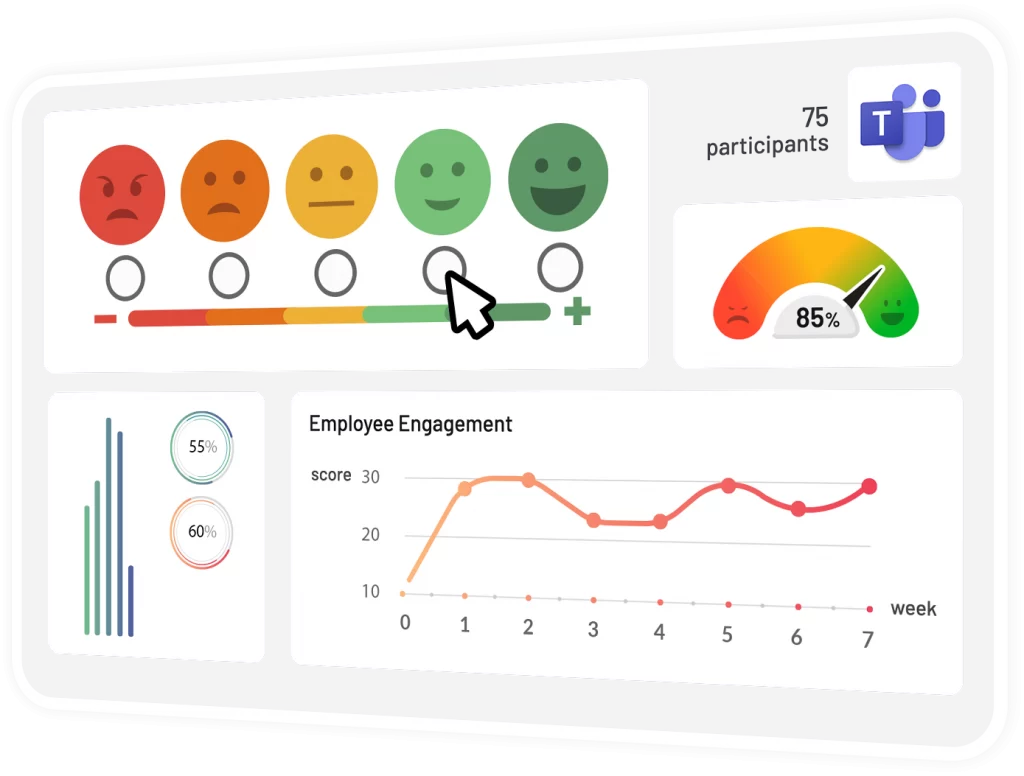Have you heard of pulse surveys before? If not, no worries — we’re here to explain what pulse survey examples are and why they’re important.
There are several different approaches to employee engagement surveys. You can check out our article Employee Engagement Surveys for a better look, but a pulse survey, in a nutshell, is a quick check-in on how your employees or team members are feeling at a specific moment in time. It’s a way to gauge the overall pulse of the workplace if you will.
Now, why are pulse surveys important? Well, they provide valuable insights into the current state of employee morale, job satisfaction, and more. By regularly conducting pulse surveys, you can stay on top of any changes in the workplace atmosphere and address any issues before they become bigger problems. It’s a proactive way to ensure a happy and productive work environment for everyone!
If you’re wondering about how to write a pulse survey and which questions to implement —you’ve come to the right place! Let’s dive right in and check out some pulse survey examples!

Table of Contents
How To Write A Pulse Survey?
1. Define The Purpose
When it comes to writing a pulse survey, defining the purpose is the first step. This is important because it sets the foundation for the rest of the survey and helps you make decisions about what questions to include.
So, what exactly do you want to learn from your pulse survey? Do you want to find out about employee morale, job satisfaction, or the overall workplace culture? Do you want to assess the impact of a new policy or initiative?
With a clear purpose in mind, you can create a targeted and effective pulse survey that will provide valuable insights into the workplace.
2. Identify Target Participants
Now that you’ve defined the purpose of your pulse survey, it’s time to identify who you want to participate in! After all, you want to make sure you’re getting a representative sample of employees or team members.
When deciding your target participants, think about who would be best suited to provide the information you’re looking for. Are you looking for feedback from all employees, or just a specific department or team? Are there certain roles or positions that you need to hear from?
It’s also important to consider the size of your target group. If you have a large workforce, you may want to focus on a smaller subgroup to start with. This will help you gather targeted feedback that’s easier to analyze and act upon.
3. Choose The Right Questions
Alright, now it’s time for the fun part – choosing the questions for your pulse survey! But with so many options to choose from, how do you know which questions are the right ones?
The key is to keep your purpose in mind and choose questions that are directly related to what you want to learn. For example, if you’re looking to assess employee morale, you might ask questions like, “How satisfied are you with your job?” or “How satisfied are you with the overall work environment?”
It’s also important to keep your questions concise and to the point. Remember, pulse surveys are meant to be quick check-ins, so keep your questions simple and easy to answer. This will encourage more participation and ensure that you’re getting valuable feedback.
And finally, consider using a mix of open-ended and closed-ended questions. Closed-ended questions are great for gathering specific data and tracking changes over time, while open-ended questions allow employees to provide more detailed feedback.
You can also use employee survey software if you feel like coming up with all the questions yourself is a hassle! With lots of customizable employee pulse survey sample, survey tools will make your job easier.
4. Determine Survey Frequency
Now that you have your questions all set, it’s time to decide how often you want to conduct your pulse survey. This is an important decision because it will determine how often you get feedback and how much data you can collect over time.
So, what frequency makes the most sense for your organization? Will you conduct a pulse survey every month, every quarter, or every year? There’s no right or wrong answer here — it all depends on what you want to learn and how often you need to check in with your employees or team members.
You can also use one-on-one meetings for implementing employee pulse surveys. Using one-on-one software during these meetings can make the pulse survey process easier!
5. Test and Launch
The last step in writing a pulse survey is to test and launch! This is your chance to make sure everything is in order and to iron out any kinks before you send the survey out to your employees or team members.
Before you launch your survey, it’s a good idea to run a test with a small group of employees or colleagues. This will give you a chance to see how the survey looks and feels, and to get feedback on any questions or issues that may arise.
Once you’ve tested your survey and made any necessary adjustments, it’s time to launch! Be sure to communicate the purpose of the survey and why it’s important to get feedback from employees or team members. This will help increase participation and ensure that you’re getting valuable insights into the workplace.

What Are Pulse Survey Questions?
Pulse Survey Examples
Employee Satisfaction
Okay, let’s dive into some of the most popular pulse survey examples! First up, employee satisfaction!
Employee satisfaction is a key indicator of how happy and engaged employees are in the workplace. It’s also a crucial factor in employee retention, as happy employees are more likely to stay with an organization long-term.A 2021 study found that nearly 73% of employees would consider leaving their current job if presented with a compelling offer, even if they were not actively seeking employment. This tells us one thing: unsatisfied employees tend to leave their job when they have the chance.
So, how do you measure employee satisfaction? Here are a few pulse survey questions to consider:
- On a scale of 1 to 10, how satisfied are you with your job?
- How satisfied are you with the work environment?
- How satisfied are you with the support and resources provided by your manager?
- How satisfied are you with the overall company culture?
By asking these types of questions, you can get a pulse on how employees feel about the workplace and what changes, if any, need to be made to improve employee satisfaction. So, don’t be afraid to ask about employee satisfaction in your pulse surveys, and you’ll be well on your way to creating a happier and more engaged workforce!
Work Culture
Next up, let’s talk about work culture! Work culture is all about the values, attitudes, and behaviors that define a workplace. It’s what makes a company unique and helps employees feel a sense of belonging and connection. Asking about workplace culture in your pulse survey examples will help you set better vision for your organization’s future.
So, how do you measure work culture in a pulse survey? Here are a few questions to consider:
- How would you describe the overall work culture at this company?
- On a scale of 1 to 10, how well does this company live up to its stated values and mission?
- How well do you feel the company values and supports diversity and inclusion?
- Do you feel comfortable bringing your whole self to work, including your unique perspectives and experiences?
Work-Life Balance
Now, let’s dive into work-life balance! This topic is all about finding the right balance between work and personal life. When employees can keep a healthy work-life balance, they tend to be more productive, motivated, and engaged in their jobs.
So, how do you measure work-life balance in a pulse survey? Here are a few questions to consider:
- On a scale of 1 to 10, how well do you feel you balance work and personal life?
- Do you feel like you have enough flexibility to take care of personal responsibilities during work hours?
- How satisfied are you with the amount of paid time off offered by the company?
- Do you feel like you’re able to disconnect from work and recharge when you’re not at the office?
So, include questions about work-life balance in your pulse surveys to have a better understanding of what your employees need to keep a healthy balance. This information can then be used to make meaningful changes that will improve the well-being of your employees and create a more balanced workplace.
Remote Work
Now let’s touch upon the topic of remote work! With more and more companies embracing flexible work arrangements, it’s important to understand how employees feel about working from home or another remote location. Implementing remote team management software can be the first step before asking these pulse survey sample questions since it will solve most of the issues you face.
To gauge employee satisfaction with remote work, you can ask questions such as:
- How satisfied are you with your current remote work arrangement?
- Do you feel like you have the necessary tools and resources to be productive when working remotely? How well do you feel you’re able to communicate with your team when working remotely?
- How do you feel about the balance between remote and in-office work?
By asking these types of questions, you can get a better understanding of how employees feel about remote work and what changes, if any, need to be made to improve the remote work experience.
Professional Development
Finally, let’s focus on professional development! Providing employees with opportunities for growth and advancement is essential for keeping them engaged and motivated. By asking questions about professional development in your pulse surveys, you can get a sense of how employees feel about their opportunities for growth and what changes, if any, are needed to support their professional development.
Some pulse survey examples of questions to ask about professional development include:
- How satisfied are you with the professional development opportunities available to you?
- Do you feel like you have the support and resources you need to grow and advance in your role?
- How often do you receive feedback on your performance and how do you feel about it?
- What additional training or development opportunities would you like to see in the future?
Pulse Survey Examples Best Practices
Keep it Short
When it comes to pulse surveys, keeping it short and sweet is key. Employees are busy, and you want to make sure that they feel comfortable and motivated to complete the survey.
By keeping your pulse survey brief, you’ll be able to get quick and valuable feedback from your employees without overwhelming them. Aim for a survey length of 5-10 questions and ensure they are focused and to the point.
Additionally, by keeping your pulse surveys short, you’ll be able to administer them more often, allowing you to get a more up-to-date and accurate picture of employee sentiment.
Provide Anonymity
Providing anonymity in your pulse surveys is a great way to encourage honest and open feedback from your employees. When employees feel that their responses will remain confidential, they are more likely to share their true thoughts and feelings.
Anonymity can be achieved by using an online survey tool that automatically hides the respondent’s identity or by using a third-party survey provider to collect and analyze the data.
Providing anonymity in your pulse surveys not only helps to ensure that you receive accurate feedback, but it also shows your employees that you value their opinions and that you are committed to creating a safe and supportive work environment.
Act On Feedback
Collecting feedback from your employees through pulse surveys is a great first step, but it’s important to follow through and act on the feedback you receive.
Showing your employees that you value their opinions and that you are committed to making positive changes based on their feedback is essential in building trust and creating a positive work environment.
When you act on the feedback you receive, it shows your employees that their opinions matter and that you are committed to creating a workplace that meets their needs and supports their well-being.
Use Data To Drive Decisions
Data from pulse surveys provides valuable insights into the attitudes, opinions and experiences of your employees. By carefully examining this information, you can identify areas for improvement, develop action plans and track progress over time. This can be particularly helpful for measuring employee satisfaction, work-life balance, and professional development opportunities. By understanding the concerns and needs of your workforce, you can make data-driven decisions that will help create a more productive and engaged workplace.
One of the best ways to make the most of pulse survey data is to use performance management software. With this tool, you can easily analyze the data, find patterns and trends, and create reports that provide a clear picture of what’s working and what needs to be improved. You can also use the software to monitor progress and make sure your action plans are working effectively. In other words, using a performance management software can help you turn your pulse survey data into actionable insights that can drive positive change in your workplace.

Conclusion
In summary, pulse surveys are quick check-ins on how employees are feeling and what changes, if any, need to be made to enhance their experience in the workplace.
By asking questions about employee satisfaction, work culture, work-life balance, remote work, and professional development, you can get a pulse on what’s working well and what needs improvement.
Best practices for pulse surveys include keeping them short, using simple language, providing anonymity, acting on feedback, and using data to drive decisions.
We hope that you now have a better understanding of pulse surveys and their benefits and are inspired to implement them in your workplace. Pulse surveys are a great way to show your employees that you care about their well-being and are committed to creating a supportive and thriving workplace. Consider using an all-in-one performance management tool such as Teamflect to make your employee pulse survey process smoother —schedule a demo now!



